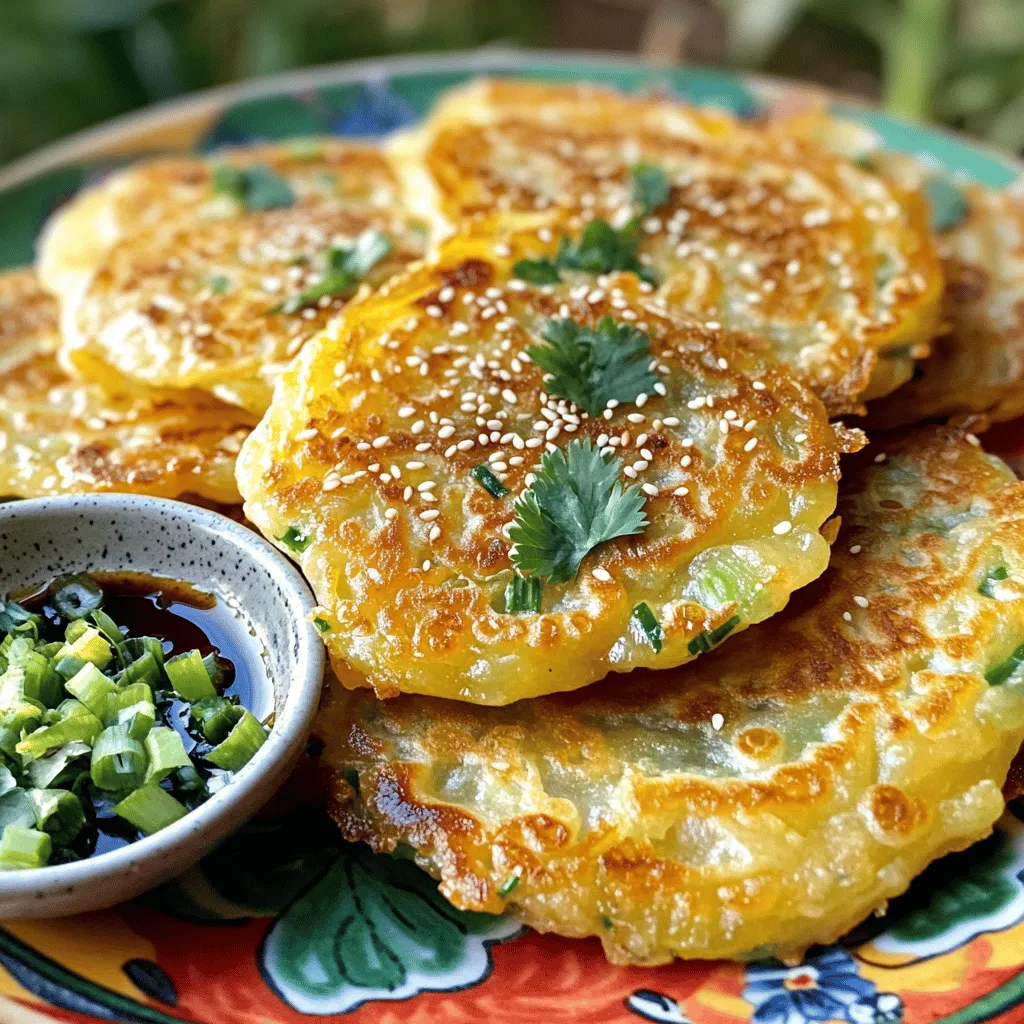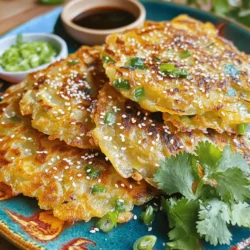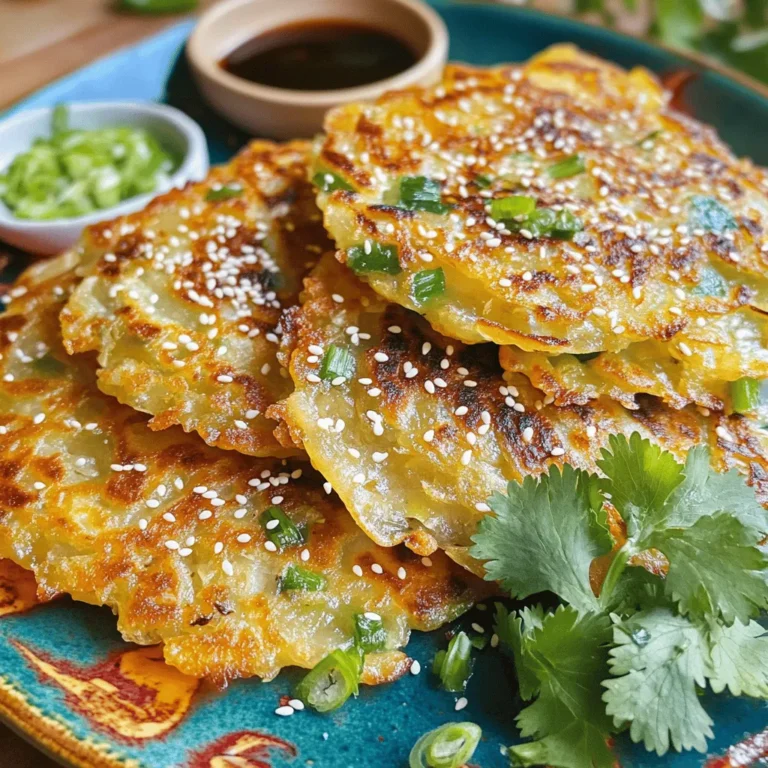If you love savory snacks, let me introduce you to Pajeon—Korean scallion pancakes that are crispy and delicious! This easy recipe mixes flour and scallions for a tasty treat you can make at home. Whether you’re a newbie or a pro in the kitchen, I will guide you through each step, from essential ingredients to cooking tips. Get ready to impress your taste buds with this delightful dish!
Ingredients
Key Ingredients Overview
Flour and Water Base
The main ingredients for a great pajeon are flour and water. I use all-purpose flour because it gives the pancake a nice texture. Mixing flour with water creates a smooth batter. This batter holds everything together.
Importance of Scallions
Scallions are the star of this dish. They add fresh flavor and a crunch. You should chop them finely so they mix well into the batter. The more scallions, the better the taste.
Optional Add-ins (Carrots, Gochugaru)
You can add grated carrots for a hint of sweetness. This makes the pancake colorful and fun. If you like some heat, consider adding gochugaru, which are Korean red pepper flakes. This gives the pajeon a spicy kick.In it, whisk together 1 cup of all-purpose flour, 1 cup of water, and 1/2 teaspoon of salt. You want a smooth batter without lumps. This batter is the foundation for your pajeon.
The Role of Each Ingredient
The flour gives the pancake its structure. Water helps to create a light texture. Salt enhances the flavors. Scallions, which you should chop finely, bring freshness and a nice crunch. If you like, add 1/2 cup of grated carrots for a touch of sweetness. For heat, mix in 1/2 teaspoon of gochugaru.
Cooking the Pajeon
Heating the Pan Correctly
Use a non-stick frying pan and heat it over medium heat. Once hot, add 2 tablespoons of vegetable oil. You need enough oil to make the pancake crispy.
Cooking Time and Texture Guidelines
Pour half of your batter into the pan, spreading it out evenly. Cook for about 3-4 minutes. The edges should crisp up, and the bottom should turn golden brown. Flip the pancake carefully using spatulas. Cook the other side for another 3-4 minutes until it’s golden and crispy.
Serving Suggestions
Ideal Dipping Sauces (Soy Sauce)
Serve your pajeon warm with soy sauce for dipping. The salty flavor pairs perfectly with the pancake.
Presentation Tips for the Final Dish
Place the scallion pancakes on a bright plate. Garnish with sesame seeds or fresh cilantro for color. A small dish of soy sauce and some chopped scallions make it look even better.
Tips & Tricks
Perfecting the Texture
Achieving Crispiness
To make your pajeon crispy, use cold water in your batter. Cold water helps create steam, which adds air and lightness. Mix the batter until smooth but don’t overmix. A few lumps are fine. Heat your pan well before adding oil. The oil should shimmer, not smoke. This step creates a nice crust.
Avoiding a Soggy Pancake
A soggy pancake is a common issue. To prevent this, keep the heat on medium-high. Avoid adding too many vegetables; they release moisture. If using carrots, make sure they’re grated fine. You can also let the batter sit for about 10 minutes. This can help thicken it slightly.
Cooking Variations
How to Adjust Ingredients for Personal Taste
Feel free to change your pajeon. Love spice? Add more gochugaru. Want a sweeter taste? Toss in extra carrots. You can even add cooked seafood or mushrooms for a twist. Just remember to keep the flour and water ratio the same for best results.
Cooking Techniques for Various Stovetops
Different stovetops can affect cooking. If you use an electric stove, set it to medium-high. For gas stoves, adjust based on how fast it heats. Use a non-stick pan if you’re new to cooking. This helps avoid sticking and makes flipping easier. If you have a cast-iron skillet, it retains heat well, giving a great crispy edge.

Variations
Popular Pajeon Variations
Pajeon has several tasty twists. One popular version is Seafood Pajeon. You can add shrimp or squid for a fresh ocean flavor. The seafood cooks quickly, adding a nice texture. Just chop the seafood into small pieces and mix it into the batter with the scallions.
Another exciting option is Kimchi Pajeon. This version includes kimchi, giving your pancake a spicy kick. The fermentation adds depth to the flavor. Simply chop your kimchi and fold it into the batter. This adds a nice tang and heat, making it perfect for spice lovers.
Vegan and Gluten-Free Options
You can enjoy Pajeon even with dietary needs. For a vegan option, replace the egg with a flaxseed meal mix. Mix one tablespoon of flaxseed meal with three tablespoons of water. Let it sit to thicken before adding to the batter.
For gluten-free Pajeon, use rice flour instead of all-purpose flour. It will give you that crispy texture you crave. You can also mix in other gluten-free flours, like almond or chickpea flour. Each adds a unique flavor while keeping things gluten-free.
Feel free to experiment with these variations. You can create your own special Pajeon that suits your taste.
Storage Info
Storing Leftovers
To keep your pajeon fresh, use proper storage techniques. First, let the pancakes cool completely. Place them in an airtight container. You can layer parchment paper between each pancake to prevent sticking. Seal the container tightly.
For refrigeration, pajeon lasts up to three days. If you want to keep them longer, consider freezing. Wrap each pancake in plastic wrap and place them in a freezer bag. This method protects them from freezer burn. Frozen pajeon can last up to two months.
Reheating Tips
To enjoy pajeon again, reheating is key. The best method is using a skillet. Heat a non-stick pan over medium heat. Add a small amount of oil to the pan. Place the pajeon in the pan and cook for about two minutes on each side. This keeps them crispy.
You can also use an oven. Preheat it to 350°F (175°C). Place the pajeon on a baking sheet. Bake for about 10 minutes or until heated through. Avoid microwaving pajeon, as this may make them soggy. Proper reheating ensures you retain their delicious texture and flavor.
FAQs
Common Questions about Pajeon
What is Pajeon?
Pajeon is a Korean scallion pancake. It combines flour, water, and scallions. This dish is crispy on the outside and soft inside. You can add optional ingredients like carrots or spicy gochugaru. It makes a great snack or side dish.
How long can I store Pajeon?
You can store Pajeon in the fridge for about 2 days. Just place it in an airtight container. To keep it fresh, reheat it in a pan. This helps restore its crispiness.
Troubleshooting Cooking Issues
Why is my Pajeon soggy?
A soggy Pajeon often comes from too much water in the batter. Make sure to follow the recipe closely. If your pan isn’t hot enough, it can also cause sogginess. Always preheat your pan before adding the batter.
How to fix burnt edges?
If the edges of your Pajeon burn, lower the heat next time. Cooking on medium heat helps prevent burning. You can also trim off the burnt parts after cooking to make it look nicer.
Cultural Significance of Pajeon
When is Pajeon traditionally served?
Pajeon is popular during rainy days in Korea. People believe it brings good luck. It is also served during celebrations like Chuseok, the harvest festival.
What are the cultural celebrations involving Pajeon?
Pajeon plays a role in many Korean festivals. It is often served at family gatherings. Making Pajeon is a way to bond and share food with loved ones.
Pajeon combines simple ingredients like flour, water, and scallions to create a tasty dish. We explored how to prepare the batter, cook it perfectly, and serve it well. Remember, adjusting flavors and textures can make it your own. Variations like seafood or kimchi add fun twists. Store leftovers properly to keep them fresh. Understanding Pajeon’s cultural background adds to its enjoyment. Cooking should be fun, so enjoy making your Pajeon just the way you like it.


